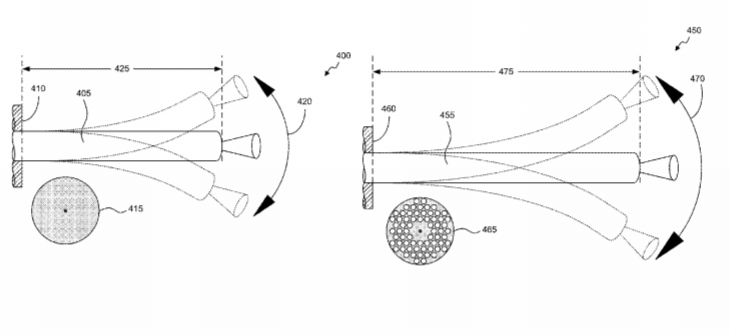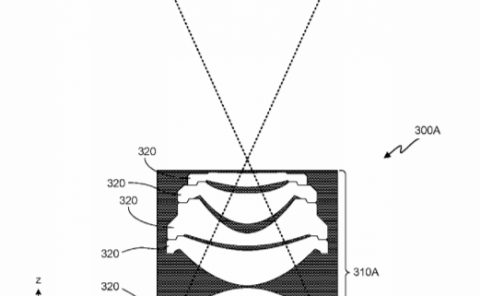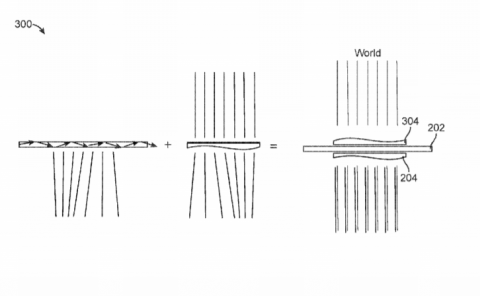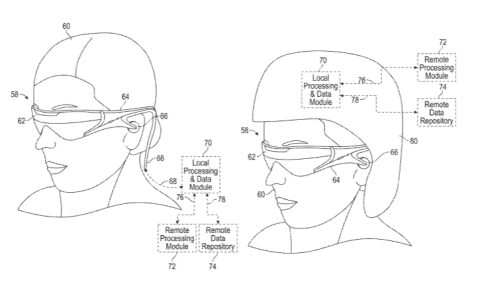Magic Leap Patent | Microstructured Fiber Optic Oscillator And Waveguide For Fiber Scanner
Patent: Microstructured Fiber Optic Oscillator And Waveguide For Fiber Scanner
Publication Number: 10451868
Publication Date: 20191022
Applicants: Magic Leap

Abstract
Described are optical fibers and scanning fiber displays comprising optical fibers. The disclosed optical fibers include a plurality of mass adjustment regions, such as gas-filled regions, positioned between a central waveguiding element and an outer periphery for reducing a mass of the optical fiber as compared to an optical fiber lacking the plurality of mass adjustment regions.
BACKGROUND OF THE INVENTION
Optical fibers have been employed for a variety of uses, including communication, sensors, and imaging. Optical fibers of various constructions exist and generally include a waveguide structure, such as a waveguide made of a central core and a surrounding cladding layer, with additional buffer and jacket layers optionally included to provide protection during handling or exposure to environmental conditions. Additional optical fiber designs and optimizations are needed to improve and expand the variety of applications that optical fibers are or can be employed in.
SUMMARY OF THE INVENTION
This application relates to optical waveguides. More specifically, and without limitation, this application relates to optical fibers and optical fiber oscillators, such as used for scanning fiber displays, where the optical fibers include a waveguiding element and a mechanical region with one or more mass reduction elements positioned between the waveguiding element and an outer periphery of the optical fiber. The inclusion of the mass reduction elements advantageously provide a scanning fiber display incorporating the optical fiber with an improvement to a field-of-view, such as when compared to use of conventional fiber optic oscillators.
Scanning devices generally trade off scanning range for frequency. For example, in general, as frequency increases, scanning range decreases. Similarly, as scanning range increases, frequency decreases. In many applications, such as scanning optical projectors, it is desirable, however, to have large operating frequency and large range. Frequency may be important for both resolution and refresh rate. For example, in a scanning fiber display, the frequency may directly impact the refresh rate, as the repeated oscillations of a fiber may dictate how frequently the output view can be changed.
Range, however, may be important for field-of-view for a given projector design. For example, the maximum amplitude or range of an oscillating fiber may provide for a limit on how wide an output image generated by the fiber may be. As the oscillation range is increased, a wider field of view may be provided.
Scanning devices may also be useful as display devices due to their small form factor and useful resolution and field-of-view. However, in order to obtain high frequency scanning devices with a high scanning range, innovations in this field are required. The presently described optical fibers allow for improved field-of-view projectors while maintaining a small form factor. As an example, by incorporating the disclosed optical fibers into a scanning fiber display projector, the field-of-view of the projector may be increased relative to conventional scanning fiber display devices.
In a first aspect, provided are optical fibers. The disclosed optical fibers may also be referred to herein as microstructured optical fibers. Example optical fibers include those comprising a waveguiding element extending along an axis; a mechanical region surrounding the waveguiding element, such as a mechanical region that is positioned between the waveguiding element and an outer periphery and that comprises a first material having a first density; and a plurality of mass adjustment regions positioned within the mechanical region, such as a plurality of mass adjustment regions that comprise a second material having a second density less than the first density. Such mass adjustment regions may optionally comprise air or may correspond to regions where material is removed or otherwise absent from the mechanical region. It will be appreciated that the first and second materials may also have different optical properties, such as different indices of refraction.
As another example, the disclosed optical fibers include optical fibers comprising a waveguiding element extending along an axis; a mechanical region surrounding the waveguiding element, such as a mechanical region that is positioned between the waveguiding element and an outer periphery and that comprises a first material; and a plurality of second moment of area adjustment regions positioned within the mechanical region, such as a plurality of second moment of area adjustment regions that serve to modify the overall second moment of area of the mechanical region as compared to an identical optical fiber except that a corresponding mechanical region of the identical optical fiber does not include second moment of area adjustment regions positioned between a corresponding waveguiding element and a corresponding outer periphery of the identical optical fiber. As an example, second moment of area adjustment regions may exhibit different mass per unit cross-sectional area than that of the first material and result in modification of the overall second moment of area of the mechanical region. As a further example, second moment of area adjustment regions may exhibit different densities than that of the first material and result in modification of the overall second moment of area of the mechanical region. It will be appreciated that the term second moment of area refers to a geometrical property of an area or object, as is known in the field of mechanical engineering, and that other terms may be used interchangeably for second moment of area, including area moment of inertial, second area moment, and moment of inertia of plane area.
A variety of waveguiding elements are useful with the optical fibers described herein. A waveguiding element may comprise a central core region and a cladding layer surrounding the central core region. Optionally, the central core region has a diameter of about 5 .mu.m to about 25 .mu.m. Optionally, the cladding layer has a diameter of about 5 .mu.m to about 200 .mu.m. Optionally, the cladding layer comprises the first material. Optionally, the central core region comprises a third material. Optionally, the central core region comprises the second material. Optionally, the cladding layer comprises a third material. Optionally, the cladding layer and the mechanical region comprise a unitary body. For example, the mass adjustment regions may optionally be positioned within or as part of the cladding layer.
Optionally, the waveguiding element corresponds to a single mode waveguiding element or a multimode waveguiding element. Other useful waveguiding elements include those comprising a plurality of core regions and a cladding layer surrounding the plurality of core regions. Optionally, each of the plurality of core regions may be the same or different materials. Other waveguiding elements are contemplated, including those comprising a hollow (i.e., evacuated) or gas- or air-filled region, such as a gas-filled core region. It will be appreciated that hollow or gas- or air-filled cores may be useful in high power applications as gas or air may absorb less energy than glass or another solid material. Optionally, evacuated regions (i.e., vacuum filed regions) may also be utilized. It will also be appreciated that core and cladding regions may exhibit different optical properties, such as different indices of refraction.
A variety of mass adjustment regions may be employed with the optical fibers described herein. For example, the mass adjustment regions may include, but are not limited to, one or more gas- or air-filled regions, one or more polymer-filled regions, one or more glass-filled regions, one or more evacuated regions, or any combination of these. As an example, the mechanical region may comprise a first glass and the mass adjustment regions may comprise a second glass that is different from the first glass. Optionally, the plurality of mass adjustment regions comprises a plurality of rows of mass adjustment elements. For example, the plurality of rows may be arranged concentrically around the central waveguiding element. Optionally, the plurality of mass adjustment regions are arranged in a symmetric configuration around the axis. Optionally, each of the plurality of mass adjustment regions has a circular cross-sectional shape, an oval cross-sectional shape, or a polygonal cross-sectional shape. Combinations of cross-sectional shapes may also be utilized. Optionally, each mass adjustment region has a cross-sectional shape with a lateral dimension or a diameter of about 1 .mu.m to about 25 .mu.m. Optionally, the plurality of mass adjustment regions traverse a length of the optical fiber, such as where each mass adjustment region has its own longitudinal axis. Optionally, each longitudinal axis is arranged with axes parallel to the axis of the optical fiber. Other configurations are possible, including where individual cells or regions of mass reduction material are included in sections of the optical fiber. The mass adjustment regions may optionally run the entire length of the optical fiber, or only a portion of the fiber. Alternatively, the mass adjustment regions are randomly or evenly distributed throughout the mechanical region, or run perpendicular to or angled from an optical or waveguide axis. Optionally, a pitch between the plurality of mass reduction regions is about 1 .mu.m to about 25 .mu.m. Optionally, the plurality of mass adjustment regions occupy between about 30% and about 90% of a volume of the mechanical region. Such a fractional or percentage volume may be referred to herein as a mass reduction fraction or mass reduction filled fraction. In the case of a mass reduction region comprising air or gas, such a fractional or percentage volume may be referred to as an air-filled fraction or gas-filled fraction.
Optionally, the optical fiber comprises a composite optical fiber having a plurality of different cross-sectional configurations. For example, the optical fiber may comprise a first segment comprising a first cross-sectional configuration and a second segment comprising a second cross-sectional configuration. In this way, an optical fiber may comprise a segment that is microstructured and a segment that is not microstructured. Segmented optical fibers may be manufactured as a single fiber with a varying cross-sectional configuration. Segmented optical fibers may also be constructed by splicing optical fibers of different cross-sectional configurations.
It will be appreciated that inclusion of mass-reduction regions may allow for selection, tuning, or otherwise modifying the mechanical properties of an optical fiber. For example, an outside diameter of the optical fiber may be proportional to a pointing angle of the optical fiber. Optionally, a mass adjustment filled fraction of the mechanical region is proportional to a pointing angle of the optical fiber. Optionally, the mass adjustment filled fraction is represented by a ratio of a diameter of the mass adjustment regions to a pitch between the mass adjustment regions.
It will be appreciated that the plurality of mass adjustment regions may reduce a mass of the optical fiber per unit length as compared to a comparable optical fiber comprising a corresponding waveguiding element that is identical to the waveguiding element and a corresponding mechanical region that is identical to the mechanical region except that the corresponding mechanical region does not include mass adjustment regions positioned between the corresponding waveguiding element and a corresponding outer periphery of the comparable optical fiber.
Optical fibers may exhibit an effective cantilever length. Optionally, the plurality of mass adjustment regions increases a resonant oscillatory frequency of the optical fiber as compared to a comparable optical fiber having the effective cantilever length and comprising a corresponding waveguiding element that is identical to the waveguiding element and a corresponding mechanical region that is identical to the mechanical region except that the corresponding mechanical region does not include mass adjustment regions positioned between the corresponding waveguiding element and a corresponding outer periphery of the comparable optical fiber. Optionally, the plurality of mass adjustment regions increases an effective cantilever length of the optical fiber for a given operating or resonant frequency as compared to a comparable optical fiber comprising a corresponding waveguiding element that is identical to the waveguiding element and a corresponding mechanical region that is identical to the mechanical region except that the corresponding mechanical region does not include mass adjustment regions positioned between the corresponding waveguiding element and a corresponding outer periphery of the comparable optical fiber.
Optical fibers, such as those having an effective cantilever length, may have a resonant frequency. Optionally, the plurality of mass adjustment regions increases an effective cantilever length of the optical fiber as compared to a comparable optical fiber having the resonant frequency and comprising a corresponding waveguiding element that is identical to the waveguiding element and a corresponding mechanical region that is identical to the mechanical region except that the corresponding mechanical region does not include mass adjustment regions positioned between the corresponding waveguiding element and a corresponding outer periphery of the comparable optical fiber.
In another aspect, scanning fiber displays are provided. For example, a scanning fiber display may optionally comprise any of the optical fibers described above and an actuator in mechanical contact with the optical fiber, the actuator for inducing an oscillation of the optical fiber. As an example, an optical fiber in a scanning fiber display may optionally comprise a waveguiding element extending along an axis; a mechanical region surrounding the waveguiding element, such as a mechanical region that is positioned between the waveguiding element and an outer periphery and that comprises a first material having a first density; and a plurality of mass adjustment regions positioned within the mechanical region, such as a plurality of mass adjustment regions that comprise a second material having a second density less than the second density.
Various actuators and actuator configurations are useful with the scanning fiber displays described herein. For example, the actuator optionally comprises a piezoelectric transducer, an electromagnetic voice coil, or a thermal actuator. Optionally, the actuator comprises a two-dimensional actuator for controlling motion of an end of the optical fiber in two dimensions. Useful actuators include those that oscillate at a controllable frequency and may be configured to operate at or about a natural or resonant frequency of an optical fiber.
The disclosed scanning fiber displays may optionally further comprise a visible optical source in optical communication with the waveguiding element of the optical fiber. For example, a multi-color switchable optical source in optical communication with the waveguiding element of the optical fiber may be used. In this way, color images may be output by the scanning fiber display by controlling the light input into the waveguiding element, such as by adjusting a color, or intensity, as a function of the position of the optical fiber.
The foregoing, together with other features and embodiments, will become more apparent upon referring to the following description, claims and accompanying drawings. It will be appreciated that the optical fibers and scanning fiber displays of the above aspects may optionally include features and aspects described in the below description.
BRIEF DESCRIPTION OF THE DRAWINGS
FIG. 1A and FIG. 1B provide schematic illustrations of example optical fiber systems in accordance with some embodiments.
FIG. 2A provides a schematic illustration of a cross-section of an example conventional optical fiber. FIG. 2B provides a schematic illustration of a cross-section of an example microstructured optical fiber.
FIG. 3A, FIG. 3B, FIG. 3C, and FIG. 3D provide schematic illustrations of different cross sections for a microstructured optical fiber.
FIG. 4A and FIG. 4B provide schematic illustrations of example optical fiber systems, showing a comparison between using a conventional optical fiber and a microstructured optical fiber.
FIG. 5A provides a schematic illustration of a spiral output pattern achieved by a scanning fiber display using a conventional optical fiber. FIG. 5B provides a schematic illustration of a spiral output pattern achieved by a scanning fiber display using a microstructured optical fiber.
FIG. 6 provides a plot showing gain in pointing angle of an optical fiber as a function of the ratio of diameter to pitch of mass reduction regions and as a function of the diameter of mass reduction regions.



